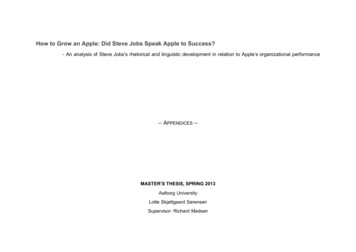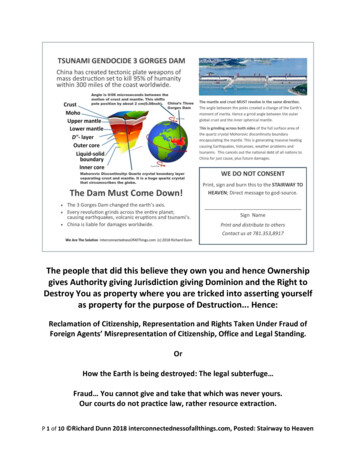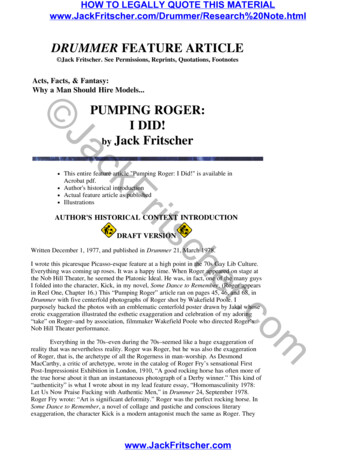
Transcription
Let’s Tour the Pyramid to get a sense of scale:https://youtu.be/TMzouTzim0oUnchartedX inside the Grand Galleryhttps://youtu.be/0rCjrc-v6T8?t 589Answer about the Pyramid City questions for Ryan.https://skeptoid.com/episodes/4191Did Jewish Slaves Build the Pyramids?“We also know quite a lot about the labor force that built the pyramids. Thebest estimates are that 10,000 men spent 30 years building the GreatPyramid. They lived in good housing at the foot of the pyramid, and when theydied, they received honored burials in stone tombs near the pyramid in thanksfor their contribution. This information is relatively new, as the first of theseworker tombs was only discovered in 1990. They ate well and received thebest medical care. And, also unlike slaves, they were well paid. The pyramidbuilders were recruited from poor communities and worked shifts of threemonths (including farmers who worked during the months when the Nileflooded their farms), distributing the pharaoh's wealth out to where it wasneeded most. Each day, 21 cattle and 23 sheep were slaughtered to feed theworkers, enough for each man to eat meat at least weekly. Virtually every factabout the workers that archaeology has shown us rules out the use of slavelabor on the pyramids.”
So, if it’s not a Tomb, what the hell is it?Christopher Dunn’s Acoustic ResonatorFrom Dunn:In ‘The Giza Power Plant’ page xix paragraph 3, I state:I began to see the drawings of the Great Pyramid, with its numerous chambers andpassageways positioned with such deliberate accuracy, as the schematics of a very largemachine. I became convinced that it could not be anything else, and I set about trying tounderstand how this machine operated. The effort could be considered similar to what isknown as the process of reverse engineering. To be successful at this, I knew that I had tofind an answer for every single detail found within the Great Pyramid. I could not ignore
any evidence or twist it in any way. I was determined to prepare a report that wasaccurate and as honest as I was capable of making it.On page123 paragraph 2, I state, “ In proposing my theory that the Great pyramid is apower plant, I am not adamantly adhering to any one proposition. The possibilities maybe numerous.”On page 255 paragraph 2, I state:My theory is that the Great Pyramid was the ancient Egyptians’ power plant. Howeverradical the idea may seem, it is, in my mind, supported by hard archaeological evidence.The artifacts reveal that the ancient Egyptians used advanced machining methods, whichsupports the deduction that their civilization, and perhaps others, was technologicallyadvanced. Nevertheless, even with the powerful evidence I have presented throughoutthis book, and the growing support for such ideas, there is still a mountain of evidence,or lack of it, that prevents this theory’s total acceptance. I acknowledge this truth, and Iam open to revising my power plant theory if another theory presents itself to explain allthe anomalies in the ancient artifacts and pyramids I have examined to build my owncase.Before you freak out:What is a Helmholtz ic properties of the Great pports-ancient-power-plant-theory“Ten days ago a study published in phys.org confirmed the existence of a concentration ofelectromagnetic energy under the base of the Great Pyramid and within its chambers.Above you can see images of the measurable electromagnetics which according to Newsweekare there purely by chance:The unusual electromagnetic properties of the pyramid are almost certainly just a coincidence ofits structure, as it is highly unlikely that the Ancient Egyptians knew anything about this.
“Louistalboys site walk-thruhttp://www.louistalboys.com/giza pyramid/
Grand Gallery & Corbeled CeilingQueens Chamber Filled with SeawaterThe salt build up: Christopher Dunns says "In 'The Giza Power Plant' I presentthe results given in 1978 by the Arizona Bureau of Geology and MineralTechnology who did a chemical analysis of this salt. They found it to be amixture of calcium carbonate (limestone), sodium chloride (halite or salt), andcalcium sulfate (gypsum, also known as plaster of paris). Patrick Flanagan,Ph.D, collected the sample and certified its origin."
Antechamber with notches.
King’s Chamber
Christoper Dunn’s Acoustic Resonator“long-standing claim by Chris Dunn that it was a large acoustical device using harmonicresonance to convert the earth’s vibration energies to microwave radiation.”
The Wooden Wheel of the Grand Gallery“ The clue is in the design of the gallery. If you recall the width of the sunkensection of floor is the same as that between the highest pair of corbelled walls.It suggests something was placed between the floor and ceiling, the mostobvious being a large wheel which ran up and down the length of the gallery,it’s axle sat in the shallow groove gouged out (perhaps by its motion) of eitherwall at slightly less than half the distance between the floor and ceiling. It wassupported in a cradle that rested on guide wheels set into those enigmaticrecesses on either side of the ramps and walls.”
The Queen’s chamber is a Pump!“The next piece of this ancient puzzle lies in the Queen’s chamber or, morespecifically, the corbelled niche. It housed a non-return valve for sea waterentering the chamber from a semi-artificial blow hole. As the tide came in, theswell forced water up into the chamber where it quickly flooded thepassageways and grand galleryHowever, with a simple open and shut valve the force of the tide alone wouldnot have been sufficient to flood the gallery to the top. The high reinforcedceiling and low doorway creates a space above the water line in which air istrapped and it is the air, which is compressed with each pulse of sea water,that acts as a non-mechanical piston to force water into the gallery as itexpands with the valve shut. The decreasing area of the valve increases theforce of air/water exiting at the top by a factor of 5 to overcome the pressure ofthe air above the water line due to the height of water in the Grand Gallery (2atm at most). A freestanding wooden box would probably not have survived
the increased force, which is why it was set into the rear wall. So, were thoseenigmatic “sealed” channels necessary to allow air into the chamber and drainit before the machine worked? (here’s a clue – they’re level with the top of thedoorway into the chamber).“Pump .gif
Drain Valves“ The three granite plugs (discovered at the lower end of the ascending passage)were originally set within the girdle stones and kept in place by woodenwedges on each side. The plugs limited the rate at which the water drainedfrom the gallery allowing it to fill more quickly than it would empty. A falsefloor at the foot of the gallery acted as a non-return valve to reduce thepressure from the head of water in the gallery and so improve the performanceof the pistonless pump in the Queen’s chamber. At rest the wooden wheel saton the valve preventing it from opening until sufficient water to float the wheelhad filled the lower gallery. This possibly stopped the wheel from bobbing upand down as the water pulsed in during the initial stages of filling, whichwould otherwise damage the gallery roof. There appears to be some evidenceof the wheel’s effect on the gallery roof to suggest the components of the wheelwere bound around the circumference by metal straps.”
Winders and RegulatorsThe heart of the machine was located in the King’s chamber. Though it lookscomplex in the diagram it was in fact a very simple arrangement of drumsused to hold ropes arranged as follows:1. Ropes (red) attached to the wooden wheel passed through atensioner in the antechamber before being wound onto a drumlocated in the King’s chamber. The tensioner is designed to take upthe slack in the red ropes with each pulse of water entering theGrand Gallery.2. A rope (blue) wound onto a second drum passed through thesouthern air-shaft to the south face of the pyramid where it wasattached to a counterweight.3. The drums were attached to the same axle and wound the (red andblue) ropes in opposing directions so that as one wound the otherunwound.
4. Ropes (yellow) fixed to the structure were wrapped around (butnot attached to ) another drum on the same axle. These ropesacted as a brake and were held taught by a single (yellow) ropewhich passed through the northern air-shaft to a float device fixedon the north face of the pyramid.Counterweight“ The (blue) rope exited the King’s southern air-shaft and was attached to adolly suspended on the south face. The stone counterweight on this dollyweighed slightly less than the wooden wheel (this is the same idea used inmodern elevators). As the wooden wheel floated up the gallery the (blue) ropeunwound as the counterweight descended. This turned the axle onto which alldrums were attached and wound the (red) rope attached to the wooden wheel.When the water started to drain from the gallery the wooden wheel rolled backdown the gallery because it was no longer supported by the water and so was
‘heavier’ than the counterweight. As it descended the (red) rope unwound,which in turn wound the (blue) rope onto its drum, raising the counterweightin the process.”FloatThe (yellow) rope exited the King’s northern air-shaft and was attached to afloat device fixed onto the north face. At high tide the wooden block in thedevice floated and the (yellow) rope became slack, which released the brakeallowing the wooden wheel to float up the gallery. At low tide the woodenblock, no longer supported by the water, pulled on the (yellow) rope. Thistightened the (yellow) ropes wrapped around the brake drum, which helpedregulate the speed of the wooden wheel as it rolled back down the gallery.
Line tensionerThe (red) ropes attached to the wooden wheel passed through a system ofpulleys in the antechamber designed to maintain the tension. This wasnecessary to take up any slack in the ropes when the wooden wheel was raisedby successive pulses of sea water in the gallery. The design of the antechamberallowed for the assembly of the device from the top. The principle was verysimple:1. Three pulleys are fixed in the recesses above the slots in theAntechamber walls.2. Four (gray) ropes fixed at the south end of the Antechamber arelooped through the pulleys, under the gray slab and fixed at thenorth end.3. Two more pulleys are suspended in loops in the (gray) ropes belowthe fixed pulleys.
4. Three (red) ropes pass through three pulleys fixed at the base ofthe Antechamber and loop through the two pulleys suspended bythe four (gray) ropes.5. The two centrally positioned pulleys are held in tension by the pullof the (red) ropes below acting against the (gray) ropes above. Asthe (red) ropes become slack the excess is taken up by the (gray)ropes pulled down by the weight of the granite slab.PowerhouseThis gives a better view of the winder mechanism and brake drum. The otherends of the four yellow ropes are fixed to the back of the structure. Thequestion now is, what did it drive?The most obvious answer is an electric dynamo . After all, every part of aniron-based machine would, in time, rust without trace. But the inclusion of adynamo would add an unnecessary leap in technology to a mechanism which
is, up to this point, well within the capabilities of the civilization that built thepyramids. It also ignores the strange arrangement of granite blocks in theso-called ‘relieving chambers’.Sonic ResonatorThe answer could lie in the piezoelectric properties of quartz contained in thegranite. Basically, when certain crystals are deformed they release a charge.The physics behind it is not yet fully understood but it is the principle behindmany cigarette and stove lighters whereby a manual trigger is used to hammera piece of quartz and generate an arc of electricity between two contacts.In the machine above the torque from the axle rotates a rosined wheel againstseveral strings to produce a constant sound in much the same way the ‘ HurdyGurdy ‘ is played. A device of substantial proportions mounted atop the‘sarcophagus’ would vibrate the entire structure of the chamber and relievingchambers above. The design of the relieving chambers is reminiscent of an air
capacitor and it may have been possible to hold electrical charge for use over aperiod longer than that during which the sound was being generated.Pyramid lighthouseGiven the location of the pyramid on the edge of the plateau the most obviousreason for building it and generating electrical current has to be a lighthouse.Although this requires slightly less of a leap in technology than the use of adynamo, a civilization capable of harnessing piezoelectricity must surely havefound ways of using it. An alternative might be the production of sound alone,the pyramid acting as a beacon.That raises the question to whom were they signaling?Another consideration is the use of close fitting, large polished limestoneblocks to withstand the constant pounding from the sea. Similar designs can
be seen today in coastal defenses around the world. Just how high must thesea level have been to warrant such a structure?Hour 2: The Standard Model vs RealityMyths Vs. Facts(Special Shoutout to UnchartedX on Youtube for the info)He’s got some great videos on YoutTube everyone should go check him out. He actually goesto these places and investigates, he’s got really cool footage that you will not see anywhereelse.TimelineThe standard model timeline tells us that the Great Pyramid was built between 20-27years. Or 13 million minutes- 2-3 million limestone blocks in the GP (2-3 tones avg)- That means, 1 block must be Cut, Transported, expertly laid every 5 minutes.- Single blocks weigh up to 70 tonnes.- All done wit
I began to see the drawings of the Great Pyramid, with its numerous chambers and . calcium sulfate (gypsum, also known as plaster of paris). Patrick Flanagan, Ph.D, collected the sample and certified its origin." Antechamber with notches. King’s Chamber . Christoper Dunn’s Acoustic Resonator “long-standing claim by Chris Dunn that it was a large acoustical device using harmonic .











